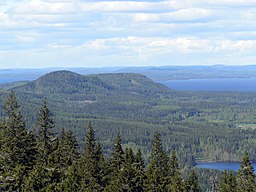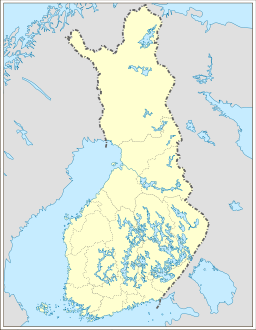Koli National Park
| Koli National Park (Kolin kansallispuisto) | |
| Protected area | |
| An elevated view at Koli | |
| Country | |
|---|---|
| Region | North Karelia |
| Coordinates | 63°03′27″N 29°53′14″E / 63.0575°N 29.88722°E |
| Area | 30 km2 (12 sq mi) |
| Established | 1991 |
| Management | Metsähallitus |
| IUCN category | II - National Park |
| Website: http://www.outdoors.fi/kolinp | |
Koli National Park (Finnish: Kolin kansallispuisto) is a national park in the municipalities of Joensuu, Lieksa and Kontiolahti in the North Karelia region of Finland. It covers 30 square kilometres (12 sq mi) in the forested hills on the western shore of lake Pielinen, and was established in 1991. Contrary to the other national parks in Finland, Koli National Park was originally governed by the Finnish Forest Research Institute Metla. It is now governed by the Metsähallitus like the other national parks[1].
Koli has lots to offer cultural heritage-wise. Former it was a sacrificial site. Later it was used for slash-and-burn agriculture. The aim of Koli National Park isn't to reserve wild nature but traditional agricultural heritage is cherished in Koli. Some fields are slashed, burnt and re-cultivated and hay is cut yearly. Traditional Finnish breeds of cows and sheep are grazing in the meadows of Koli.
Contents[hide] |
[edit] Nature
The national park of Koli has been divided into three different zones according to central protection objectives.
Attention is paid to a national landscape and geology in a zone which covers the highest tops of Koli. The culture zone is located quite near a village. In the culture zone the multiformity of the tradition landscapes is maintained by burn-beating, by grazing and by managing open fields by among others mowing. The yard circles with their old buildings on the open field and on the pasturage graze the pearls of the burn-beaten area culture in the middle of the open manmade landscape lined by the koivikko, the kyyttö and sheep are. Especially the multiform flora of open fields needs annual maintenance mowing in order to be preserved. To the nature zone the forest nature of dangers is protected. The nature of Koli is well varying from the point of view of the terrain and thanks to it there is a large number of different biotopes even in a small area and thus the species a very multiform one. The laws of rocks are fairly rugged, the shady slopes in the covering of the old spruces or birches and from the field slopes of valleys shadily moist groves grow rank.
[edit] Attractions
The most well-known vantage point in the park is Ukko-Koli, with a grand view to the East, over the lake Pielinen. Near the top there's the Heritage Center Ukko and Hotel Koli. In the summer, two long scenery lifts are working in Koli.
There are also many caves in Koli area, e.g. the cave named Pirunkirkko. It is 34 metres (110 ft) long and 1–7 metres (3.3–23 ft) high.
Koli has inspired many painters and composers, e.g. Jean Sibelius, Juhani Aho and Eero Järnefelt. Eero Järnefelt painted together with A.W. Finch and Ilmari Aalto a large scenery about Koli in 1911. It can be seen in the restaurant of Helsinki railway station. Painters found Koli in the 19th century and after that Koli has been called one of the national sceneries of Finland.
Nowadays there are two ski resorts in Koli area: Loma-Koli for families and Ukko-Koli for more advanced downhill skiing. There are three ski lifts and six ski slopes in Ukko-Koli. The highest vertical drop is 230 metres (750 ft) and ski slopes are 800–1,500 metres (2,600–4,900 ft) long. There are four ski lifts and six ski slopes in Loma-Koli. The highest vertical drop is 145 metres (480 ft) and ski slopes are 530–1,050 metres (1,700–3,400 ft) long. Two of the slopes are streets for snowboarding. There are also snow castles for children.
[edit] See also
[edit] References
- ^ "Metla : Kolin kansallispuisto : Kolin matkailupalvelut monipuolistuvat : Tiedote 3.1.2006" (in Finnish). 2007-09-07. http://www.metla.fi/koli/tiedotteet/koli-tiedote-20070907-puisto.htm. Retrieved February 18 2008.
[edit] External links
| Wikimedia Commons has media related to: Koli National Park |
- Outdoors.fi – Koli National Park
- Koli National Park webpage
- Video about travelling in Koli area - by students from Koli area
- Video about downhill skiing in Koli - by students from Koli area
| |||||














